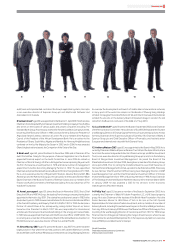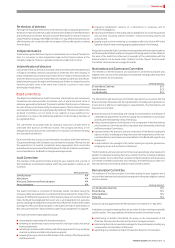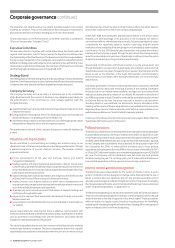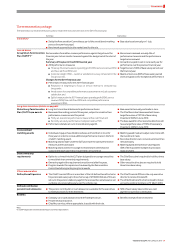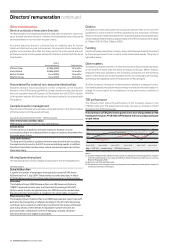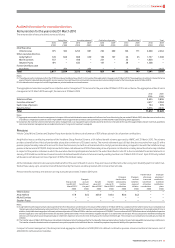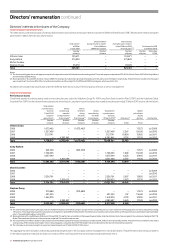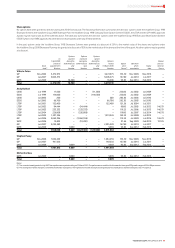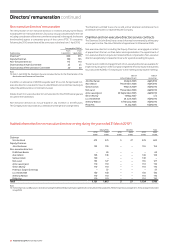Vodafone 2010 Annual Report Download - page 60
Download and view the complete annual report
Please find page 60 of the 2010 Vodafone annual report below. You can navigate through the pages in the report by either clicking on the pages listed below, or by using the keyword search tool below to find specific information within the annual report.
58 Vodafone Group Plc Annual Report 2010
Directors’ remuneration continued
Overview of remuneration philosophy
Remuneration policy
The Remuneration Committee commissioned a full review of the reward
arrangements for the Company’s executive directors in the 2008 financial year and
the remuneration policy was last updated at this point. The policy is felt to be
appropriate for the coming financial year.
Vodafone wishes to provide a level of remuneration which attracts, retains and
moti vates executi ve directors of th e highest cal ibre. To maximise the ef fectiveness
of the remuneration policy careful consideration will be given to aligning the
remuneration package with shareholder interests and best practice.
The aim is to target an appropriate level of remuneration for managing the
business in line with the strategy. There will be the opportunity for executive
directors to achieve significant upside for truly exceptional performance.
In setting total remuneration the Remuneration Committee will consider a
relevant group of comparators which will be selected on the basis of the role
being considered. Typically no more than three reference points will be used.
These will be as follows: top European companies, top UK companies and,
particularly for scarce skills, the relevant market in question.
These comparators reflect the fact that currently the majority of the business is
in Europe, the Company’s primary listing is in the UK and that the Remuneration
Committee is aware that, in some markets, the competition is tough for the very
best talent.
A high proportion of total remuneration will be awarded through short-term and
long-term performance related remuneration. The Remuneration Committee
believes that incorporating and setting appropriate performance measures and
targets in the package is paramount – this will be reflected in an appropriate
balance of operational and equity performance.
Finally, to fully embed the link to shareholder alignment, all executive directors
are expected to comply with the rigorous and stretching share ownership
requirements set by the Remuneration Committee.
Summary of key reward philosophies
Link to business strategy
Performance conditions have been determined to align with business strategy
and to maximise shareholder value.
The annual bonus continues to support the short-term operational performance
of the business by measuring against the business fundamentals of revenue,
profit, cash flow and competitive performance.
The long-term incentive measures performance against:
free cash flow, which is believed to be the single most important operational
measure; and
total shareholder return (‘TSR’) relative to our key competitors.
Shareholder alignment
The executives are required to meet stretching share ownership
requirements which are supported by the opportunity to invest into the long-
term incentive plan.
The performance conditions on the long-term incentive plan are there to
underpin shareholder value creation.
Summary of key reward philosophies (continued)
Risk and reward
In setting the balance between base salary, annual bonus and long-term
incentive levels, the Remuneration Committee has considered the risk involved
in the incentive schemes and is satisfied that the following design elements
mitigate the principal risks:
the heavy weighting towards long-term incentives;
the need for short-term incentive payouts to be used to purchase and
hold investment shares in order to fully participate in the long-term
arrangements; and
the enhanced weighting on non-financial measures in the short-term plan.
The Remuneration Committee will continue to consider the risks involved in
the incentive plans on an on-going basis.
Changes to plans for the 2011 nancial year
The table below sets out any changes to the individual elements of the reward
package for the 2011 financial year:
Reward elements 2011 financial year
Base salary No change to the benchmarking policy.
Annual bonus There has been a re-balancing of the
weighting for the performance measures
to focus on service revenue. A competitive
performance assessment has been
introduced which incorporates net
promotor score and in some markets
customer delight index.
Long-term incentive plan No change to the plan design.
Investment opportunity No changes to the level of investment
an individual may make.
Setting remuneration levels
The remuneration package for executive directors is benchmarked by reference to
total data for the base salary, annual bonus and long-term incentive levels combined.
The principal comparator group (used for benchmarking only) is made up of 28 top
European companies excluding any in the financial services sector.
When undertaking the benchmarking process the Remuneration Committee makes
assumptions that individuals will invest their own money into the long-term incentive
plan. This means that individuals will need to make a significant investment in order
to achieve a market competitive level of remuneration.
Comparison of the ratio of fixed pay to variable pay
The base salary and pension contributions to executives are considered to be fixed
levels of remuneration. The annual bonus and the long-term incentive awards are
variable, i.e. the actual value the executive receives will depend on the performance
of the Company.
As can be seen below the variable elements of the executive directors remuneration
package are in excess of 77% assuming target performance, maximum co-investment
and no movement in current share price.
Analysis of executive directors pay as a percentage of total package
Chief Executive Other executive directors
21.4
21.4
6.4
50.8
Long-term
incentives
Bonus
Pension
allowance
Base
22.7
22.7
6.8
47.8
Long-term
incentives
Bonus
Pension
allowance
Base



